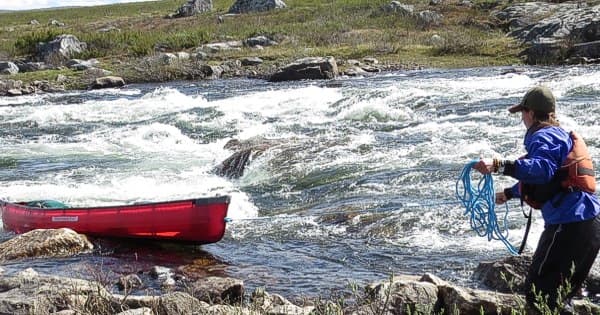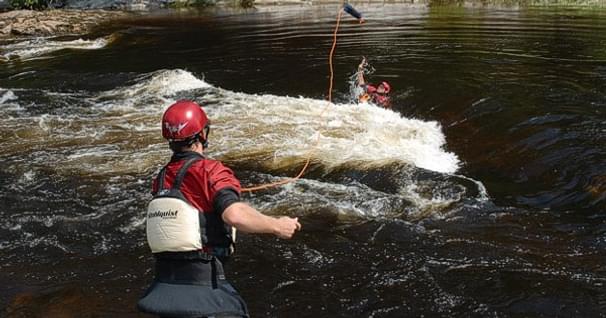Lining a Canoe with a Single Rope
Read this article to get tips on the process of guiding your canoe on a rapid from the shoreline with a solo rope.
On a recent Lapland canoe trip we did a lot of lining because of high water levels. Some of the "lining" was up and down mountain sides, but that is a story for another day. We had a group of solo canoes, and it was obvious that we could make much faster progress if each of us could deal with his or her own canoe without a partner handling a second rope. The group covered a range of experience with lining, and I could observe what worked well - and not quite as well.

The Rope
I like to use a 3/8" diameter kernmantle-style polypropylene rope, about 50 ft long in a bright (not white) color. Polypropylene will float and minimize the potential to snag on rocks, and the better quality ropes are less likely to snag in the coil you are holding. Cheap twisted poly ropes are much harder to work with. I like to make a loop for my hand at the end of the rope to guard against accidentally feeding out all the rope and losing the canoe.
The Canoe
To prepare the canoe for lining, you should add attachment points for ropes at the ends, just above the water line. A low rope attachment will minimize the risk of capsizing the canoe when you have to pull hard on the rope.
I have often loaded my canoe slightly to the stern. This is not a good idea if you are lining with a stern rope because the river may grab your stern and pull it sideways to the current. It can take considerable force to correct this, and the risk of a mishap is high. Loading the canoe completely level makes its behavior more neutral - and it becomes easier to control a back ferry.
The Lining
To use 50 ft of rope, it is essential to avoid snags. Coil the rope neatly before you start lining so you can drop one loop at the time and feed out the rope smoothly, all the way to the end. If you can't do this, there is no point in having a 50 ft rope. When you bring the canoe back in, you must again coil the rope neatly while you walk towards the canoe so that the rope is ready to use again. This will be repeated multiple times if you are lining some distance. Most of the time, you will let out much less than the full length - but if you go to the end of the rope, start slowing the canoe down well before the end, and make sure your footing is solid!
Do not "micro manage" the canoe. It is often better to let it find its own way because it will naturally follow the volume of the water. Of course, you must interfere if it looks like the canoe may go where you do not want it to. Often, a slight tug on the rope is enough to correct the direction.
It is easy to assume that it is safer to line with two ropes than with one. While that is true in some situations, there are many situations when it is not. With two people lining the same canoe, communication and coordination are crucial, and a misunderstanding can easily cause a capsize. There are times when momentum will carry the canoe safely through a turbulent spot. Launching the canoe into the current and letting it run until it reaches calmer water may then be the safest option. The control you get from using two ropes may slow the canoe down and work against you.
We had a situation where there was a hole on the left and turbulent water deflected off a boulder on the right. There was a safe route for the canoes between the two trouble spots, but the canoes would have to be launched with some momentum into its route off a large flat boulder. Our other option was a challenging liftover on shore. The situation was resolved by two people launching each canoe, and the person with the rope letting the canoe run freely until it reached calmer water. The operation was repeated without incident six times and saved a considerable amount of effort. Adding a second rope would have exposed us to the turbulence around the boulder on the right, and we felt that the risk would be higher.
If you are new to lining, you should start practicing in easy river situations. Lining with a single rope is fast and is often the easiest and safest way to get down a tricky rapid. But it takes time to develop a feel for how the canoe will behave in a given situation. If you like to go on wilderness canoe trips (in particular if you paddle solo) single rope lining is a very useful skill, and you will find that it is fun too.
Alv Elvestad owns Pakboats, a supplier of folding canoes to expedition paddlers. He loves paddling his "home" rivers in northern Scandinavia and visits there whenever he can. Many Lapland rivers are small, steep and technical streams. The easiest way to navigate is with a compact solo canoe, and lining becomes a useful skill. When he is not canoeing Arctic Lapland rivers, Alv can often be found kayaking New Hampshire lakes.
Related Articles
Casting out a rescue throw line, either contained within a Throw Bag or gathered in coils requires…
One of the most critical, and versatile pieces of kayaking gear is a workable length of line. Most…
One of the lowest-risk and most effective techniques for reaching a victim is by use of a throw rope. In…
Picture yourself approaching a set of rapids, with only a faint out-of-the-way animal trail heading up a…


